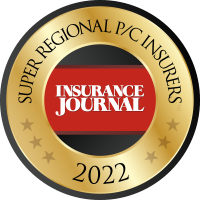Secure your future today!
Practical Steps to Control Workers’ Compensation Costs

How much in extra sales do you need to make to cover the cost of workplace accidents? Workers’ compensation insurance covers medical and wage losses but does not cover all accident costs.
Indirect costs include:
- Administration expenses to handle claims
- Customer service delays
- Damaged material or customer property
- Lost sales or technical skills
- Personal impact on the injured person
OSHA estimates that the average $500 workers’ compensation claim results in $2,250 of indirect cost to the employer. This directly affects profits, unless additional sales offset the expenses.
While the primary goal is to prevent accidents to protect people, clear safety guidelines that are followed by workers can also contribute to business profitability. There are several ways to help control workers’ compensation costs with practical pre-accident and post-accident steps.
Hiring and Training
Good hiring practices are the first step toward building a safety culture and controlling workers’ compensation costs. Every company looks for employees with good work habits, and who are reliable and make good decisions independently. This is especially important when safety so often depends on people following safe work practices on their own.
Full orientation training should include company rules, safety rules, and accident reporting policy. OSHA requirements for training on specific topics must be covered, such as safety data sheets, forklift operation, or respirator use.
During orientation, it is also important to cover policies and set expectations for how the new employee will demonstrate that they understand safety procedures and company expectations. Companies with the best safety records explain accident prevention goals and expectations to all new employees at the start of their orientation to demonstrate its importance. This simple step does not cost any money or take any additional time.
Don’t forget to cover post-accident topics like accident reporting and the return-to-work program. New employees need to understand the importance of reporting injuries promptly and that the company will find transitional work for them until they are fully released from work restrictions.
The final step is to follow up with the new employee after they are hired to reinforce safety best practices. Check with the employee within the first week of work to see if they are following the company rules. An employer can also assign a lead person to work with and mentor the new employee. All the good intentions from orientation in the office will be undone if the new person learns bad habits from other employees in the first week on the job.
Hazard Control
Management can uncover safety and health problems before personal injuries, property damage, or business interruptions occur. Basic practices that management can follow include:
- Conduct safety audits: A safety audit is a very effective tool to identify and address hazards before losses occur. Even a quick daily walk through the shop or worksite by management can remind employees to be aware of safety. Involve others when auditing your program. Team members may differ from management’s opinion on a safety topic. You have the best chance for success by involving everyone in the process.
- Identify hazards: Make a list of the key hazards and risks in your operation that could cause injuries. Meet as a team to determine if additional controls are needed to address the hazards. Many corrective actions are inexpensive but will yield significant benefits.
- Investigate all accidents and near-misses: Investigations provide an opportunity to prevent another accident and to possibly improve an operation. Accident investigations are not intended to find fault with the injured person, but to uncover facts and take steps to prevent other accidents. Investigating near-misses gives management the opportunity to address risks before an actual injury occurs.
- Set expectations and build culture: Management sets the tone for safety, just like sales or customer service. Even something as simple as starting every meeting with a brief discussion of a safety topic sends an important message. On the other hand, allowing worksite housekeeping to deteriorate, or letting people take safety shortcuts, also sends an unintended message that these are acceptable practices.
The time and resources that you spend up front on prevention are less than the time and resources that you will spend after accidents occur.
Claim Reporting
Even after an accident occurs, management can take critical steps that will help to control the final claim cost. It is very important to report claims as soon as possible, preferably within 24 hours of an incident. The benefits from early claim reporting are faster treatment for the injured person and the involvement of a professional claim handler. When claims are reported late, information is not as fresh or accurate.
These guidelines should be part of every claim reporting policy:
- Document: Maintain notes and reports on every case. Complete thorough accident investigations immediately after an accident.
- Look for red flags: You may receive a tip or information that leads you to question the validity or seriousness of a claim. Provide this information when you report the claim to your Human Resources department and to Hastings Insurance.
- Train all managers and team members: All employees must understand their responsibility to report injuries. Managers are in a key position and must understand the importance of reporting cases to the office as soon as possible.
If you have a Hastings Insurance Workers’ Compensation policy, contact First Call at 1-844-871-8628. First Call is a free 24/7 work injury reporting hotline offered by Hastings Insurance that quickly directs injured employees to a medical provider, reduces lost time, and helps manage workers’ compensation costs. It’s free, easy to use, and provides faster medical assistance for the injured person. For life-threatening injuries, call 911.
Early Return to Work
Finding work for people who have activity restrictions is one of the most important parts of claim management, to help people recover faster and return to their normal duties sooner. Let the injured person know they are valuable and needed. Please remember that the goal is not just to return an employee to work but for a person to achieve a full recovery as soon as possible.
Find something of value for the person to do that meets their restrictions. Does your business, shop, or office need cleaning or filing done? Can the person help with any safety issues or projects? Is there a project that you have been putting off because no one has time? The objective is to get the employee back into a structured environment and not stay home. It is vital for the injured person to feel productive and needed. Keep communication positive and frequent!
What do you do if the person cannot return to a light duty task? At the very least, a few times a week, supervisors or management should call someone who is out of the workplace to stay in touch. This plays two critical roles: It lets the employee know they are missed, and it keeps management aware of the employee’s current status. The worst situation is to have someone at home with no contact from anyone from the company.
Materials Available
Hastings Insurance Company offers sample Early Return to Work Program and Accident Investigation forms to assist with these guidelines.
Supervisor Investigation Report Guide
Download This Article
Additional Safety Topics
Check Out All Our Products
Commercial Insurance Built for You
We offer a wide range of Commercial insurance products. Find the product that's right for you!
Specialty Insurance
Commercial Auto Insurance Workers' Compensation Insurance Manufacturing Insurance Insurance for WineriesConstruction and Contracting
General Contractor Insurance Carpenters Insurance Plumbing Insurance Excavator Insurance Electrician Insurance HVAC Business Insurance Lawn Care Business InsuranceRetail and Service
Retail Business Insurance Barber Insurance Pet Grooming Insurance Florist Insurance Bakery Insurance Photographer Insurance Beautician Insurance Coffee Shop Insurance Funeral Home Insurance Janitorial InsuranceGet Insurance for Your Car and Home
You need to protect more than just your business. Get insurance for your personal property too!
Personal Lines InsuranceWe've Got You Covered!
We offer Personal Lines Insurance in five states: Ohio, Michigan, Illinois, Indiana, and Wisconsin.
Insurance for All Types of Farms
Hastings offers a range of products specifically designed for farmers.
Farm InsuranceWe've Got You Covered!
We offer Farm Lines Insurance in five states: Ohio, Michigan, Illinois, Indiana, and Wisconsin.
Secure your future today!
Hastings Insurance Company
404 E. Woodlawn Ave.
Hastings, MI 49058
Monday-Friday
8:00 a.m. - 4:30 p.m. (EST)
(800) 442-8277
Terms of Use and Privacy Statement© Hastings Insurance Company. All rights reserved.



